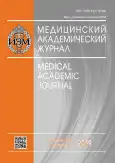PRESERVED NUMBER OF OREXIN NEURONS IN POSTMORTEM HYPOTHALAMIC TISSUE OF CHRONIC ALCOHOLICS
- Authors: Kudriavova AS1, Meskenaite V2, Mikhailov VI3, Schesny M2, Korneva EA1, Gavrilov YV1, Valko PO2
-
Affiliations:
- Institute of Experimental Medicine, Saint Petersburg
- University Hospital Zurich
- Alexandrovskaya City Hospital, Saint Petersburg
- Issue: Vol 19, No 1S (2019)
- Pages: 91-92
- Section: Articles
- Published: 15.12.2019
- URL: https://journals.eco-vector.com/MAJ/article/view/19341
- ID: 19341
Cite item
Abstract
Keywords
Full Text
About the authors
A S Kudriavova
Institute of Experimental Medicine, Saint Petersburg
V Meskenaite
University Hospital Zurich
V I Mikhailov
Alexandrovskaya City Hospital, Saint Petersburg
M Schesny
University Hospital Zurich
E A Korneva
Institute of Experimental Medicine, Saint Petersburg
Y V Gavrilov
Institute of Experimental Medicine, Saint Petersburg
P O Valko
University Hospital Zurich
References
- Harris GC, Aston-jones G. Arousal and reward: a dichotomy in orexin function. TRENDS in Neurosciences. 2006;10(29):571-577.
- James MH, et al. Increased Number and Activity of a Lateral Subpopulation of Hypothalamic Orexin/Hypocretin Neurons Underlies the Expression of an Addicted State in Rats. Biological Psychiatry. 2018.
- Schneider ER, et al. Orexigenic peptides and alcohol intake: Differential effects of orexin, galanin, and ghrelin. Alcoholism: Clinical and Experimental Research. 2007;11(31):1858-1865.
- Thannickal TC, et al. Opiates increase the number of hypocretin-producing cells in human and mouse brain and reverse cataplexy in a mouse model of narcolepsy. Science Translational Medicine. 2018;447(10):eaao4953.
- Valko PO, et al. Increase of histaminergic tuberomammillary neurons in narcolepsy. Annals of Neuro¬logy. 2013;(6)(74):794-804.
Supplementary files







